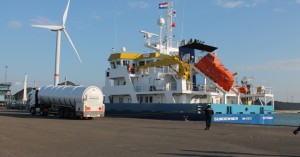LNG Bunkering Pilot in the Port of Vlissingen
 On Monday April 11th, the pilot for the bunkering of Liquefied Natural Gas (LNG) via the Truck to Ship method was successfully launched in the port of Vlissingen. Bunkering of this renewable marine fuel emphasises port authority Zeeland Seaports’ objectives to reduce overall emissions.
On Monday April 11th, the pilot for the bunkering of Liquefied Natural Gas (LNG) via the Truck to Ship method was successfully launched in the port of Vlissingen. Bunkering of this renewable marine fuel emphasises port authority Zeeland Seaports’ objectives to reduce overall emissions.
The pilot began with LNG being refuelled from a truck on the quay in the port of Vlissingen. Zeeland Seaports will determine whether consistent LNG bunkering will be realised in the port based on the results of the pilot, which will last until the end of the year.
LNG is a great alternative fuelling solution due to its zero sulphur content and its combustion produces relatively low NOx compared to other fuel oil and marine diesel oil. The bunkering of LNG in Zeeland will increase the attractiveness of the ports and significantly reduce CO2 and nitrogen emissions. Both these items are listed in Zeeland Seaports’ recently presented Strategic Master Plan. This plan includes the objective to realise facilities or solutions for LNG bunkering and become a major player in the LNG chain by 2020.
In October of 2015, Chemgas approached Zeeland Seaports to examine the potential for LNG bunkering via the Truck to Ship method. This led to the development of a plan titled ‘Pilot LNG bunkering Truck to Ship’, in cooperation with regional safety and environmental associations. The pilot is unique in that it is already running which can be contributed to an efficient collaboration between all parties involved and short lines of communication with stakeholders.
Prior to being bunkered, LNG is first liquefied through a cooling process of -162 °C. At this temperature and atmospheric pressure, the gas condenses to a liquid, thus reducing the volume by 600 times (in comparison to gaseous state), and the gas can be more easily transported and stored.






